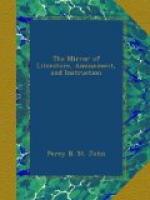“What a striking contrast between the appearance of the brilliantly illuminated streets at this time, compared with the days of Henry V. It is recorded, that in 1417, Sir Henry Barton, mayor of London, ordained ’lanterns with lights to bee hanged out on the winter evenings between Hallowtide and Candlemasse.’ Paris was first lighted by an order issued in 1524; and in the beginning of the sixteenth century, the streets being infested with robbers, the inhabitants were ordered to keep lights burning in the windows of all such houses as fronted the streets. In 1668, when some regulations were made for improving the streets of London, the inhabitants were reminded to hang out their lanterns at the usual time; and in 1690 an order was issued to hang out a light, or lamp, every night as soon as it was dark, from Michaelmas to Christmas. By an act of the common council in 1716, all housekeepers, whose houses fronted any street, lane, or passage, were required to hang out, every dark night, one or more lights, to burn from six to eleven o’clock, under the penalty of one shilling. In 1736, the lord mayor and common council applied to parliament for an act to enable them to erect lamps; and in 1744 they obtained farther powers for lighting the city. Birmingham was first lighted by lamps in 1733, so that in this improvement it preceded the metropolis.”—Beckman’s History of Inventions.
It may not be disagreeable to our readers to trace the brilliant lights by which the streets are illuminated, from the obscure recesses of nature, and to show by what steps that which was once thought simply an object of curiosity, has been applied to a practical purpose of the most useful and agreeable kind.
The inflammable gases were known originally for their direful effects rather than their useful qualities. Miners were acquainted with two of them, called the choke damp and the fire damp, long before the establishment of the Royal Society; but the earliest printed account of either occurs in its Transactions, in the year 1667. The paper in which it is contained, is entitled, “A Description of a Well and Earth in Lancashire taking Fire, by a Candle approaching to it. Imparted by Thomas Shirley, Esq an eye-witness.”
Dr. Stephen Hales was the first person who procured an elastic fluid from the actual distillation of coal. His experiments with this object are related in the first volume of his Vegetable Statics, published in 1726. From the distillation of “one hundred and fifty-eight grains of Newcastle coal, he states that he obtained one hundred and eighty cubic inches of air, which weighed fifty-one grains, being nearly one third of the whole.” The inflammability of the fluid he thus produced was no part of his inquiry; and though it is now deemed its most useful and important property, appears to have excited no attention till several years after.
In the “Philosophical Transactions” for 1733, some properties of coal-gas are detailed in a paper called, “An Account of the Damp Air in a Coal-pit of Sir James Lowther, sunk within Twenty Yards of the Sea.” This paper, as it contains some striking facts relating to the inflammability and other properties of coal-gas, is deserving of particular attention.




